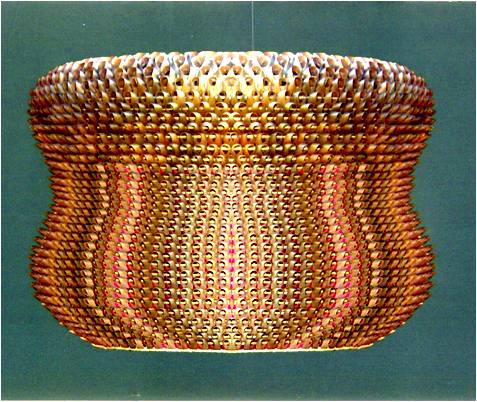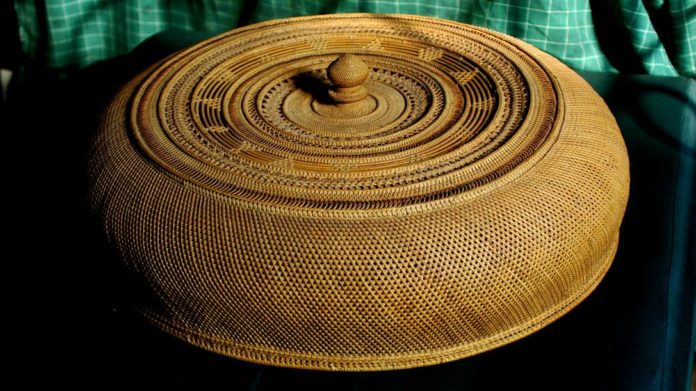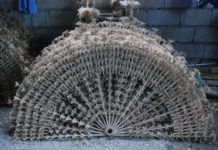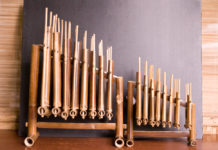Rattan and bamboo weaving has been the most common crafts in Vietnam as any farmer would know how to weave in order to create his own works for his family’s daily use and make tools for agriculture and fishing in the past. Nowadays, there are more than 700 rattan and bamboo weaving villages that are still in active.
 Vietnam has different kinds of bamboo trees, cultivated in forests or in low-lying plains. They vary in thickness, flexibility, length, but all of them can be used for weaving. A bamboo tree will be cut in pieces according to the marks on the tree and removed of lines. Its shell will be scraped, split into bars, and then split down into weaving spokes. The thickness and size of the spokes are depended on the requirements of the products. There are hundreds of Vietnamese techniques in weaving bamboo. The results vary in thickness and stiffness.
Vietnam has different kinds of bamboo trees, cultivated in forests or in low-lying plains. They vary in thickness, flexibility, length, but all of them can be used for weaving. A bamboo tree will be cut in pieces according to the marks on the tree and removed of lines. Its shell will be scraped, split into bars, and then split down into weaving spokes. The thickness and size of the spokes are depended on the requirements of the products. There are hundreds of Vietnamese techniques in weaving bamboo. The results vary in thickness and stiffness.
Rattan and bamboo weaving is still developing and providing an important source of exports, creating jobs for more than one million farmers. The artists have also been creative with more ways of weaving, which leads to more valuable fine art works. Some famous handicraft villages are Hoang Thinh Village, Thanh Hoa; Thai My Village, Ho Chi Minh City, Tang Tien Village, Bac Giang. The well-known villages for exporting works are Bang So Village, Hanoi; Bao La Village, Hue-Thua Thien. Some outstanding bamboo-weaving artists are Mr. Thai Dai Phong (Nghe An), Mrs. Nguyen Thi Thu (Bang So) based on many of their bamboo weaving combined with traditional lacquer works.
 Rattan weaving is also an expanding craft. Rattan is made from calameae trees, which are mostly grown in jungles and planted around fences. A calameae tree is 3-5 m tall, has a diameter of 1-1.5 cm. It calameae tree is collected at three-five years of age. After being plucked of its leaves, the tree is split into multiple strands each 3-5 mm wide, depending on the product. The core is removed and the outer casing reduced to 1-1.5 mm thick. Rattan weaving is applied with some similar techniques as bamboo weaving, yet has its own crafts, especially flower braiding technique, rolling skills, interlacing flower braids. Because of its soft fibres, spokes and cores with a diameter of 4-6 mm long are used as the frame of the product. Rattan-made products are usually slim, elegant, and slender so that they are applied with other high-end products, with many types of decoration. It is made into baskets, boxes and containers that are frequently exported.
Rattan weaving is also an expanding craft. Rattan is made from calameae trees, which are mostly grown in jungles and planted around fences. A calameae tree is 3-5 m tall, has a diameter of 1-1.5 cm. It calameae tree is collected at three-five years of age. After being plucked of its leaves, the tree is split into multiple strands each 3-5 mm wide, depending on the product. The core is removed and the outer casing reduced to 1-1.5 mm thick. Rattan weaving is applied with some similar techniques as bamboo weaving, yet has its own crafts, especially flower braiding technique, rolling skills, interlacing flower braids. Because of its soft fibres, spokes and cores with a diameter of 4-6 mm long are used as the frame of the product. Rattan-made products are usually slim, elegant, and slender so that they are applied with other high-end products, with many types of decoration. It is made into baskets, boxes and containers that are frequently exported.
The most renowned rattan-weaving village is Phu Vinh, Hanoi. Besides the premium products like light shades, bottles and boxes, the Phu Vinh artists can also weave into pictures and types of patterns on the product surface. The most excellent rattan-weaving artist is Mr. Nguyen Van Tinh. He and his two children all have received government recognition as a People’s Artisan (awarded by Ministry of Industry and Trade) of Rattan-Weaving, achieving many rewards. Nowadays, Phu Vinh Village has been a tourist venue, and the artist’s house displays many beautiful art works.





